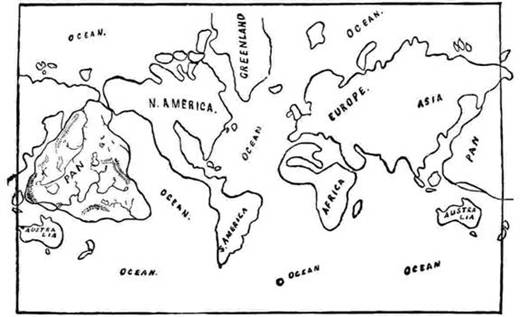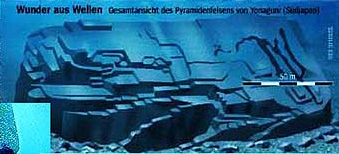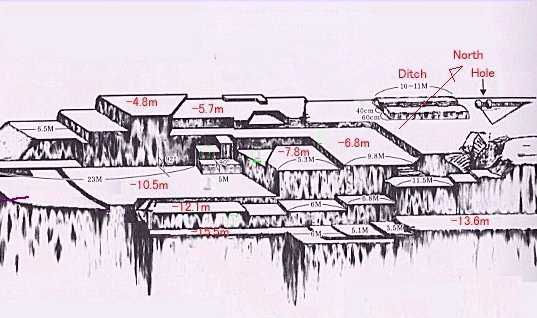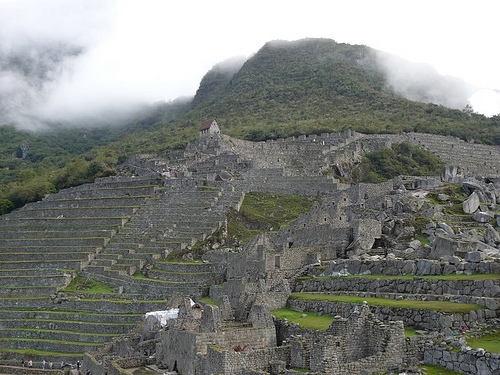Oahspe Study
Undersea Ruins of Japan - Remnants of Pan the Submerged Continent
The extensive undersea ruins first discovered only late last century off the coast of the southernmost Japanese islands and other nearby islands of Taipei, are accepted by Japanese archaeological researchers to be manmade by an earlier civilization. When or who these people were, is not known to those researchers. The similarity of the undersea ruins, to those on islands nearby, is unmistakable---the similarity to ancient ruins in other parts of the globe is remarkable!
The article referenced below points out the striking similarity of the `Yonaguni Monument' to Machu Pichu in Peru. Archaeologists, however, believe that Machu Pichu was constructed by the Incas around 1400 c.e. But the rock plateau of the Yonaguni Monument has to be more than 10,000 years old because its location has not been above sea level since then.
Why then would there be such similarities? One reason, I believe, is something the researchers will not realize, unless they know about the submerged continent of Pan, and its geography.
According to the map in Oahspe which shows the locality of Pan in the Pacific Ocean before it was submerged, the west coast of the continent ran parallel to the border of the Asian continent where the Sea of Japan and the East and South China Sea separated the two land masses. When the Continent of Pan was submerged, the mountainous regions along this coastline remained exposed, since the continental crust was cut at the border of the northern mountains.
Oahspe; The Lords' First Book; 11/1.55.
The fleet of two ships carried to the north was named Yista, which in the Whaga tongue, was Zha’Pan, which is the same country that to this day is called Japan, signifying, relic of the continent of pan, for it lay to the north, where the land was cleaved in two.

Pre-Flood Map showing position of Pan in the Pacific Ocean
Where high mountainous areas were submerged, south of the Northern Mountains of Pan, (what is now south of the main islands of Japan), the higher areas remained exposed existing as low lying islands surrounded by lower levels not far beneath the surface near the coastlines. Thus the similarities of structures found on the islands with those under the sea nearby.
Any of these ancient buildings of Pan would likely have the characteristics that mountain building would require. Machu Picchu in Peru, a stone building complex built on the top of a mountain would also require structural techniques to create stability, involving series of stepped foundations, and so the striking similarity.
|
This corresponds to the lower left quarter of the Yonaguni monument as depicted in above image. (Sketch by Kihachiro Aratake, the discoverer of the monument) |
|
|
To the right is a view of Machu Pichu. The similar broad stepped masonry features can be seen in the Yonaguni Monument also. |
Image of Machu Pichu courtesy of Flickr/Myben.be |
Archaeological Analysis of Yonaguni
|| Besides its artificiality, there is another archaeologically rather important aspect of the monument that looks obvious seeing the step structures with their combination of straight and non-straight angles: a similarity to the constructions in Peru, specifically Machu Picchu. Further investigation of this possible connection is found in the Yonaguni-Peru gallery.||
||..... The structure off the coast of Yonaguni has been hailed as "the world's oldest building" (Barot, 1998), taking the form of a "stone ziggurat" dating back to [no later than] 8000 B.C. (Barot, 1998). The Yonaguni Monument is over 50 meters long in an east-west direction and over 20 meters wide in a north-south direction. The top of the structure lies about 5 meters below sea level, whereas the base is approximately 25 meters below the surface..... based on well-established standard curves of sea- level rises in the region, as recently as 8,000 to 10,000 years ago the Yonaguni Monument may have been above local sea level. Thus we can suggest with some confidence that if the Yonaguni Monument is a man-made construction then it must be at least 8,000 years old.....
We should also consider the possibility that the Yonaguni Monument is fundamentally a natural structure that was utilized, enhanced, and modified by humans in ancient times. The Yonaguni Monument may even have been a quarry from which blocks were cut, utilizing natural bedding, joint, and fracture planes of the rock, and thence removed for the purpose of constructing other structures which are long since gone. ||
All Oahspe references are from the Standard Edition Oahspe of 2007
●
GO TO NEXT ARTICLE:
Stories of the Flood Part 1.


